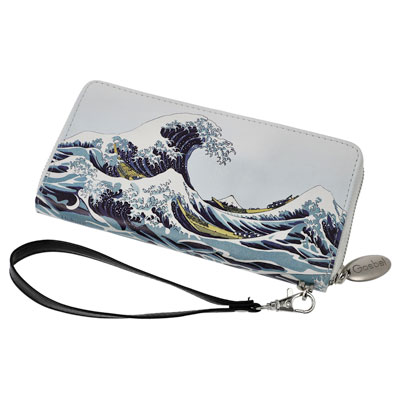Tel : (+33) 4 94 63 18 08
9am - 6pm from Monday to Sunday
All products Katsushika Hokusai • Products of the topic Children
Hokusai Wooden Puzzle for kids : The Fields of Sekiya
REF : PUZ-WIL-HOK-02
In stock
Only 1 in stock
Unavailable
36,90 €
(40.44 USD)
Puzzle Katsushika Hokusai : "The Fields of Sekiya"
Wooden Puzzle for kids : 100 pieces (8 - 12 years)
Publisher : Michèle Wilson
Dimensions of the puzzle once completed : 29 x 21 cm
Ukiyo-e
Ukiyo-e is a style of Japanese painting and woodblock printing that flourished during the Edo period (1603-1868). The word "Ukiyo-e" means "pictures of the floating world," and refers to the Buddhist belief that the material world is fleeting and unsatisfactory. Ukiyo-e works were primarily intended for a middle-class audience and were often inspired by everyday life, leisure, and entertainment of the time. The earliest Ukiyo-e works were produced in the 17th century and developed during the 18th century through the use of woodblock printing, which allowed for mass production of prints. Ukiyo-e reached its peak in the 19th century, with artists such as Katsushika Hokusai and Utagawa Hiroshige becoming famous for their landscapes and scenes of everyday life in Edo. Hokusai, who lived from 1760 to 1849, is perhaps the most famous of the Ukiyo-e artists. He is known for his series of prints "The Thirty-six Views of Mount Fuji," which was widely admired and imitated by Western artists. Hiroshige, who lived from 1797 to 1858, was also a renowned Ukiyo-e artist, known for his landscapes and scenes of everyday life in Edo. In addition to painting and woodblock printing, Ukiyo-e also included other art forms such as wallpaper, kakemonos (silk painting scrolls), and surimono (printed greeting cards). These works were produced in large quantities and were widely accessible to a broad audience. Ukiyo-e has had a great influence on Western art, particularly on Impressionist and Post-Impressionist painters. Western artists were fascinated by the simplicity and beauty of Ukiyo-e compositions, as well as the use of bright colors and clear lines. Many Western artists collected Ukiyo-e works and were inspired by them in their own work. Ukiyo-e experienced a decline in the 19th century with the advent of photography and paper printing, which made woodblock and copperplate printing techniques obsolete. However, the influence of Ukiyo-e on Western and Japanese art continues to this day.
Discover the artist
Hokusai Katsushika
Katsushika Hokusai was a Japanese painter and draftsman, specializing in ukiyo-e, popular painting and Japanese prints from the Edo period.
Hokusai is the Japanese print at its peak. Simplicity and fluidity of line combine with a chromatic research of great freedom which gives his works, and in particular the thirty-six views of Mount Fuji and the famous Great Wave of Kanagawa, a modernity that has never wavered.
The 30,000 drawings he left behind when he died are also there to remind us that, in addition to being a artist, Hokusai was an inexhaustible craftsman...
Hokusai Katsushika
Katsushika Hokusai was a Japanese painter and draftsman, specializing in ukiyo-e, popular painting and Japanese prints from the Edo period.
Hokusai is the Japanese print at its peak. Simplicity and fluidity of line combine with a chromatic research of great freedom which gives his works, and in particular the thirty-six views of Mount Fuji and the famous Great Wave of Kanagawa, a modernity that has never wavered.
The 30,000 drawings he left behind when he died are also there to remind us that, in addition to being a artist, Hokusai was an inexhaustible craftsman...
Hokusai Katsushika
Katsushika Hokusai was a Japanese painter and draftsman, specializing in ukiyo-e, popular painting and Japanese prints from the Edo period.
Hokusai is the Japanese print at its peak. Simplicity and fluidity of line combine with a chromatic research of great freedom which gives his works, and in particular the thirty-six views of Mount Fuji and the famous Great Wave of Kanagawa, a modernity that has never wavered.
The 30,000 drawings he left behind when he died are also there to remind us that, in addition to being a artist, Hokusai was an inexhaustible craftsman...
Hokusai Katsushika
Katsushika Hokusai was a Japanese painter and draftsman, specializing in ukiyo-e, popular painting and Japanese prints from the Edo period.
Hokusai is the Japanese print at its peak. Simplicity and fluidity of line combine with a chromatic research of great freedom which gives his works, and in particular the thirty-six views of Mount Fuji and the famous Great Wave of Kanagawa, a modernity that has never wavered.
The 30,000 drawings he left behind when he died are also there to remind us that, in addition to being a artist, Hokusai was an inexhaustible craftsman...
Hokusai Katsushika
Katsushika Hokusai was a Japanese painter and draftsman, specializing in ukiyo-e, popular painting and Japanese prints from the Edo period.
Hokusai is the Japanese print at its peak. Simplicity and fluidity of line combine with a chromatic research of great freedom which gives his works, and in particular the thirty-six views of Mount Fuji and the famous Great Wave of Kanagawa, a modernity that has never wavered.
The 30,000 drawings he left behind when he died are also there to remind us that, in addition to being a artist, Hokusai was an inexhaustible craftsman...











































































































